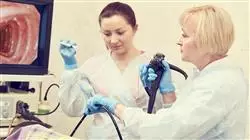University certificate
The world's largest faculty of nursing”
Introduction to the Program
The study of Intestinal Microbiotics for Nursing opens the door to knowledge of multiple illnesses, giving your resume a great boost” The study of Intestinal Microbiotics for Nursing opens the door to knowledge of multiple illnesses, giving your resume a great boost”

Numerous pieces of scientific evidence have implicated the intestinal microbiome and its metabolic potential in various pathological conditions in recent years, giving rise to new therapeutic strategies to control and regulate this ecosystem. The study of this ecosystem is a field that is rapidly advancing scientifically, and it is universally accepted that to achieve an adequate state of health it is also necessary to have a "healthy" Microbiota.
The human microbiota undergoes changes as a consequence of the influence of multiple factors, diet, lifestyle, pharmacological treatments, etc., generating alterations in this bacterial ecosystem and the anomalous interaction that the organism could have with it is related to certain processes: allergies, acute and chronic intestinal diseases, obesity and metabolic syndrome, neurological diseases, dermatitis and other alterations in the dermis, and even some types of cancer.
This Postgraduate diploma in Intestinal Microbiota in Nursing focuses on equipping nurses with the necessary information on the units related to Intestinal Microbiota, its Eubiosis and Dysbiosis and related problems.
The use of probiotics and prebiotics and the growing market launch of new products with very specific strains for problems and diseases of the intestinal tract will also be addressed. All this content will make it possible for nursing professionals to be prepared to offer effective solutions to patients with this type of pathology, knowing how to guide them so that they can recover and maintain their intestinal microbiota and, consequently, a good state of health.
This Postgraduate diploma in Intestinal Microbiota in Nursing will give you a sense of confidence in the performance of your profession. This will help you grow personally and professionally"
This Postgraduate diploma in Intestinal Microbiota in Nursing contains the most complete and up-to-date scientific program on the market. The most important features include:
- Development of practical cases presented by experts in Intestinal Microbiota in Nursing
- The graphic, schematic, and practical contents with which they are created provide scientific and practical information on the disciplines that are essential for professional practice
- What's new in Intestinal Microbiota in Nursing
- Contains practical exercises where the self-evaluation process can be carried out to improve learning
- With special emphasis on innovative methodologies in Intestinal Microbiota in Nursing
- All of this will be complemented by theoretical lessons, questions to the expert, debate forums on controversial topics, and individual reflection assignments
- Availability of content from any fixed or portable device with internet connection
This Postgraduate diploma is the best investment you can make in the selection of a refresher program for two reasons: in addition to updating your knowledge in Intestinal Microbiotics, you will obtain a degree from TECH Global University"
Its teaching staff includes professionals belonging to the field of Human Microbiota, who bring to this education the experience of their work, in addition to recognized specialists belonging to leading scientific societies.
Thanks to its multimedia content, developed with the latest educational technology, it will allow the professional a situated and contextual learning, that is to say, a simulated environment that will provide an immersive learning, programmed to train in real situations.
This program is designed around Problem-Based Learning, whereby the physician must try to solve the different professional practice situations that arise throughout the program. For this purpose, the physician will be assisted by an innovative interactive video system created by renowned and experienced experts in the field of Human Microbiota with extensive teaching experience.
The Postgraduate diploma allows education through simulated environments, which provide immersive learning programmed to train for real situations”

This 100% online Postgraduate diploma will allow you to combine your studies with your professional work while expanding your knowledge in this field”
Why study at TECH?
TECH is the world’s largest online university. With an impressive catalog of more than 14,000 university programs available in 11 languages, it is positioned as a leader in employability, with a 99% job placement rate. In addition, it relies on an enormous faculty of more than 6,000 professors of the highest international renown.

Study at the world's largest online university and guarantee your professional success. The future starts at TECH”
The world’s best online university according to FORBES
The prestigious Forbes magazine, specialized in business and finance, has highlighted TECH as “the world's best online university” This is what they have recently stated in an article in their digital edition in which they echo the success story of this institution, “thanks to the academic offer it provides, the selection of its teaching staff, and an innovative learning method aimed at educating the professionals of the future”
A revolutionary study method, a cutting-edge faculty and a practical focus: the key to TECH's success.
The most complete study plans on the university scene
TECH offers the most complete study plans on the university scene, with syllabuses that cover fundamental concepts and, at the same time, the main scientific advances in their specific scientific areas. In addition, these programs are continuously being updated to guarantee students the academic vanguard and the most in-demand professional skills. In this way, the university's qualifications provide its graduates with a significant advantage to propel their careers to success.
TECH offers the most comprehensive and intensive study plans on the current university scene.
A world-class teaching staff
TECH's teaching staff is made up of more than 6,000 professors with the highest international recognition. Professors, researchers and top executives of multinational companies, including Isaiah Covington, performance coach of the Boston Celtics; Magda Romanska, principal investigator at Harvard MetaLAB; Ignacio Wistumba, chairman of the department of translational molecular pathology at MD Anderson Cancer Center; and D.W. Pine, creative director of TIME magazine, among others.
Internationally renowned experts, specialized in different branches of Health, Technology, Communication and Business, form part of the TECH faculty.
A unique learning method
TECH is the first university to use Relearning in all its programs. It is the best online learning methodology, accredited with international teaching quality certifications, provided by prestigious educational agencies. In addition, this disruptive educational model is complemented with the “Case Method”, thereby setting up a unique online teaching strategy. Innovative teaching resources are also implemented, including detailed videos, infographics and interactive summaries.
TECH combines Relearning and the Case Method in all its university programs to guarantee excellent theoretical and practical learning, studying whenever and wherever you want.
The world's largest online university
TECH is the world’s largest online university. We are the largest educational institution, with the best and widest online educational catalog, one hundred percent online and covering the vast majority of areas of knowledge. We offer a large selection of our own degrees and accredited online undergraduate and postgraduate degrees. In total, more than 14,000 university degrees, in eleven different languages, make us the largest educational largest in the world.
TECH has the world's most extensive catalog of academic and official programs, available in more than 11 languages.
Google Premier Partner
The American technology giant has awarded TECH the Google Google Premier Partner badge. This award, which is only available to 3% of the world's companies, highlights the efficient, flexible and tailored experience that this university provides to students. The recognition as a Google Premier Partner not only accredits the maximum rigor, performance and investment in TECH's digital infrastructures, but also places this university as one of the world's leading technology companies.
Google has positioned TECH in the top 3% of the world's most important technology companies by awarding it its Google Premier Partner badge.
The official online university of the NBA
TECH is the official online university of the NBA. Thanks to our agreement with the biggest league in basketball, we offer our students exclusive university programs, as well as a wide variety of educational resources focused on the business of the league and other areas of the sports industry. Each program is made up of a uniquely designed syllabus and features exceptional guest hosts: professionals with a distinguished sports background who will offer their expertise on the most relevant topics.
TECH has been selected by the NBA, the world's top basketball league, as its official online university.
The top-rated university by its students
Students have positioned TECH as the world's top-rated university on the main review websites, with a highest rating of 4.9 out of 5, obtained from more than 1,000 reviews. These results consolidate TECH as the benchmark university institution at an international level, reflecting the excellence and positive impact of its educational model.” reflecting the excellence and positive impact of its educational model.”
TECH is the world’s top-rated university by its students.
Leaders in employability
TECH has managed to become the leading university in employability. 99% of its students obtain jobs in the academic field they have studied, within one year of completing any of the university's programs. A similar number achieve immediate career enhancement. All this thanks to a study methodology that bases its effectiveness on the acquisition of practical skills, which are absolutely necessary for professional development.
99% of TECH graduates find a job within a year of completing their studies.
Postgraduate Diploma in Intestinal Microbiota for Nursing
At TECH Global University, we present our Postgraduate Diploma program in Gut Microbiota for Nursing. If you are a healthcare professional passionate about understanding the critical role that the gut microbiota plays in health and wellness, this is your opportunity to specialize in this ever-evolving field. Our program offers high-quality online classes, allowing you to access specialized education from the comfort of your home. Take advantage of online classes and study at your own pace, without geographical restrictions or time constraints. Gain the knowledge you need to excel in your career while maintaining your personal and professional commitments.
Discover the fascinating world of the gut microbiota and its impact on health.
In the Postgraduate Diploma in Gut Microbiota for Nursing, you'll explore the most recent advances in gut microbiota research and its relationship to health and disease. You will learn about the composition of the microbiota, its role in digestion and metabolism, as well as its influence on the immune system and overall well-being. Our team of microbiology and Nursing experts will guide you through the key concepts and clinical applications of gut microbiota. You will gain practical skills to assess, promote and maintain gut microbiota health in your patients. In addition, you will gain knowledge on the use of probiotics, prebiotics and other strategies for the care and restoration of the gut microbiota. Stand out in the nursing field and become a leader in the study and care of the gut microbiota. with this Postgraduate Diploma in Gut Microbiota for Nursing from TECH Global University, you will be prepared to meet the current and future challenges of gut health. Don't miss the opportunity to expand your knowledge and make a difference in your patients' lives. enroll in the Postgraduate Diploma in Gut Microbiota Postgraduate Diploma for Nursing program at TECH Global University and discover the fascinating world of gut microbiota!







